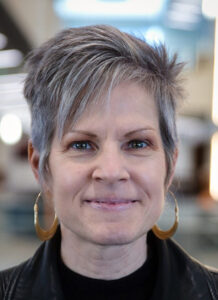Hollie Raynor, associate dean of research and professor of nutrition in the University of Tennessee, Knoxville’s College of Education, Health and Human Sciences, is a nationally recognized researcher in lifestyle interventions that focus on improving eating and leisure activity behaviors for obesity treatment in children and adults.

Hollie Raynor
Recently appointed by the US Department of Health and Human Services and Department of Agriculture to serve on the 2025 Dietary Guidelines Advisory Committee, Raynor will be one of 20 scientists producing a report with recommendations for the 10th edition of Dietary Guidelines for Americans.
These guidelines serve as the foundation for national nutrition programs, standards, and education. They inform food assistance programs such as school breakfast programs and WIC, and help assess quality of the diet consumed in practice and in research.
For Raynor, another important contribution the committee will make is the use of a health equity lens when reviewing the current body of science on nutrition topics. That means the committee will ensure that factors such as socioeconomic status, race, ethnicity, and culture are described and considered to the greatest extent possible based on the information provided in the scientific literature to develop guidance that can meet the needs of all Americans.
We sat down with Raynor to discuss her research and the multiple contributions she is making at UT and to our nation in the field of human health and nutrition.
You are involved in so many interesting and important initiatives and programs. Professionally, what is your favorite thing that you do?
Research is my favorite thing that I do. But I’m particularly interested in how my research can have an impact on people. I trained in helping professions—as a dietitian and a clinical psychologist. I clearly have a desire to be able to help people in their lives from a health perspective. So while I get super excited about all the research I do, it is really important to see the research translate into practice.
Can you give us an example of research you’ve seen translated into practice?
Yes. One example is the work we began with Cherokee Health Systems, which has been ongoing but formally became an initiative with the university with the signing of the memorandum of understanding. In my research, we are taking programs and interventions developed in a more traditional research setting by research staff, and supporting CHS staff in delivering these programs and interventions to people in the community. We think we have something that works and is helpful, though it’s still in the very early stages.
For the MOU, we have a working group that meets quarterly and we’re in the process of developing a mission and value statement and an overall strategic plan beneficial for both CHS and UT. The focus of the plan is on developing the workforce, conducting research, and improving the health of Tennesseans. Our goal is to be an exemplar of a federally qualified health center and university relationship.
I remember at the event held last year to announce the MOU, it was inspirational to hear about the unique partnership with CHS, a federally qualified health care center. Can you explain the significance of this partnership for our readers?
East Tennessee and the Appalachian region are unique in the United States in terms of culture and health needs. CHS provides health care services to the underserved, especially in their more rural-focused clinics. When practice-based guidelines are developed for health care providers to use to deliver care to the community, these guidelines have traditionally come from efficacy studies—studies done under ideal circumstances. However, the populations we generally see in these studies do not always represent the populations experiencing the health disparities and inequities that we see in our region.
To really have an impact on population health in East Tennessee, we need to engage and reach, from a research perspective, those individuals experiencing these disparities and inequities. This requires a different approach than conducting controlled research in a university-based research setting. Being able to make relationships with community partners at CHS, who are embedded in the community and understand the community needs, allows us at UT to hear those needs and work reciprocally with CHS to address those community needs. This is incredibly unique.
From your research, how would you describe the culture of East Tennessee and Appalachia?
My first thought is to describe it from a food perspective, probably because of my training background and where I work. The culture has many individuals who are potentially close to where food is grown but who may also have limited resources. This means there is a focus on acquiring or making food that is more shelf stable and can last for long periods of time.
Can you give an example of shelf-stable food?
This isn’t really a shelf-stable perspective, but when I first came here from Southern California I realized vegetables were thought of differently here. I remember going to restaurants and seeing a vegetable platter option on the menu where you can pick four or five different vegetable sides. It was interesting to see macaroni and cheese and other food options that aren’t vegetables, or choices that are vegetables or fruit but are fried or baked with sugar and butter, on the list of choices. But for shelf stability, using salt or sugar to preserve food are examples of extending the shelf life but are not usually considered healthy options. Highly processed food is also very shelf stable. Also, once you get out of a metropolitan area, if you are not growing your own food there can be very limited access to fresh foods. Depending on where somebody lives, for example, the closest option to shop for food may be Weigel’s [a gas station and convenience store chain], where many of the foods are highly processed and not incredibly healthy from a cardiometabolic standpoint.
You mentioned in an earlier interview that the 2025 Dietary Guidelines Advisory Committee will use a health equity lens when reviewing scientific evidence to assist in developing their recommendations. Is this the sort of information that informs that lens?
Yes, it is, in regards to culture. And another example is the sort of historical health disparity experienced in this area, particularly in areas of cardiovascular disease and diabetes. In some ways people feel it’s inevitable, like “Everybody in my family has diabetes.” It’s just accepted as part of life. This can be reflected in the way some of these health conditions are talked about. For example, I will hear people talk about diabetes, saying, “I have a touch of the sugar.” It does not have to be that way. As a health researcher, I recognize there are numerous initiatives that can be put into place so people don’t develop diabetes or cardiovascular disease. Having access to healthy food is important to address this.
There has been a lot of talk recently about semaglutides—a new batch of drugs, with brand names such as Wegovy and Ozempic, that have been developed to control high blood sugar in people with Type 2 diabetes but are also proving to have good results for weight loss. Outside of diet and lifestyle changes, what do you think about medical interventions to treat obesity?
In 2013, the American Medical Association came out and indicated that obesity is a disease in and of itself, and obesity increases the risk of the development of other diseases. I think anybody who does lifestyle intervention research like I do—focused predominantly on eating and activity behaviors—unfortunately recognizes the limitation of the tools that we have right now. We have so much more that needs to be done. For those who seek care in the area of obesity treatment, I think behavior, combined with other tools such as helpful medication, or even metabolic surgery or bariatric surgery, should be options, and that importantly people should have equal access to these tools and appropriate care related to them. Ensuring access to this care is important to address the health disparities and inequities we see.
_
CONTACT:
Christie Kennedy (865-974-8674, ckennedy@utk.edu)
